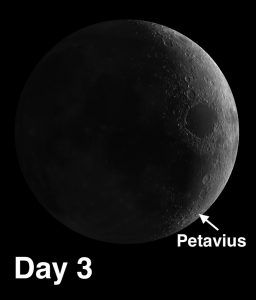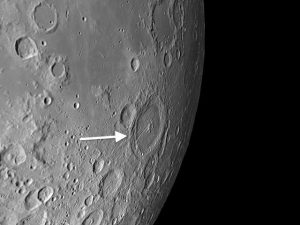The week of September 10-16 takes us from Day 1 to Day 7. This week we will highlight the crater Petavius, viewable on Wednesday night.
 Petavius: [SE/M16] This is one of the most fascinating craters on the Moon. It is an example of a floor-fractured crater (FFC), a type of crater that has been modified by later volcanism, uplift, and consequent fracturing. The floor of Petavius is nearly 1,000 feet higher near its center than around the edge! Is the curvature of the lunar surface apparent on its floor? Turbulence and volcanic upheaval from below split the central mountain (which rises to nearly one mile above the floor) and formed the rilles.
Petavius: [SE/M16] This is one of the most fascinating craters on the Moon. It is an example of a floor-fractured crater (FFC), a type of crater that has been modified by later volcanism, uplift, and consequent fracturing. The floor of Petavius is nearly 1,000 feet higher near its center than around the edge! Is the curvature of the lunar surface apparent on its floor? Turbulence and volcanic upheaval from below split the central mountain (which rises to nearly one mile above the floor) and formed the rilles.
 The principal rille, Rima Petavius, is so prominent that it can be seen with a 60mm refractor. It is a graben, an elongated depression that results when stresses open up two parallel cracks in the lunar crust and the terrain in between drops. The rille extends from the central peak to the southwest wall. There is actually a system of rilles on the floor. How many can you see with your instrument?
The principal rille, Rima Petavius, is so prominent that it can be seen with a 60mm refractor. It is a graben, an elongated depression that results when stresses open up two parallel cracks in the lunar crust and the terrain in between drops. The rille extends from the central peak to the southwest wall. There is actually a system of rilles on the floor. How many can you see with your instrument?
======================
It is highly recommended that you get a copy of Sky and Telescope’s Field Map of the Moon, the very finest Moon map available for use at the telescope. It is available for $10.95 at www.skyandtelescope.com and on Amazon. All features mentioned in this blog will be keyed to the grid on the Field Map and will look like this: Plato: [NW/D9]
Credits:
Courtesy of Gray Photography of Corpus Christi, Texas
Lunar photos: NASA / USGS / BMDO / LROC / ASU / DLR / LOLA / Moon Globe. Used by permission
- Rupes Cauchy: A Best Known Fault on the Moon - July 22, 2024
- Moon Crater Schickard – Crater Floor has Stripes - July 15, 2024
- Moon Craters Langrenus and Vandelinus - July 8, 2024